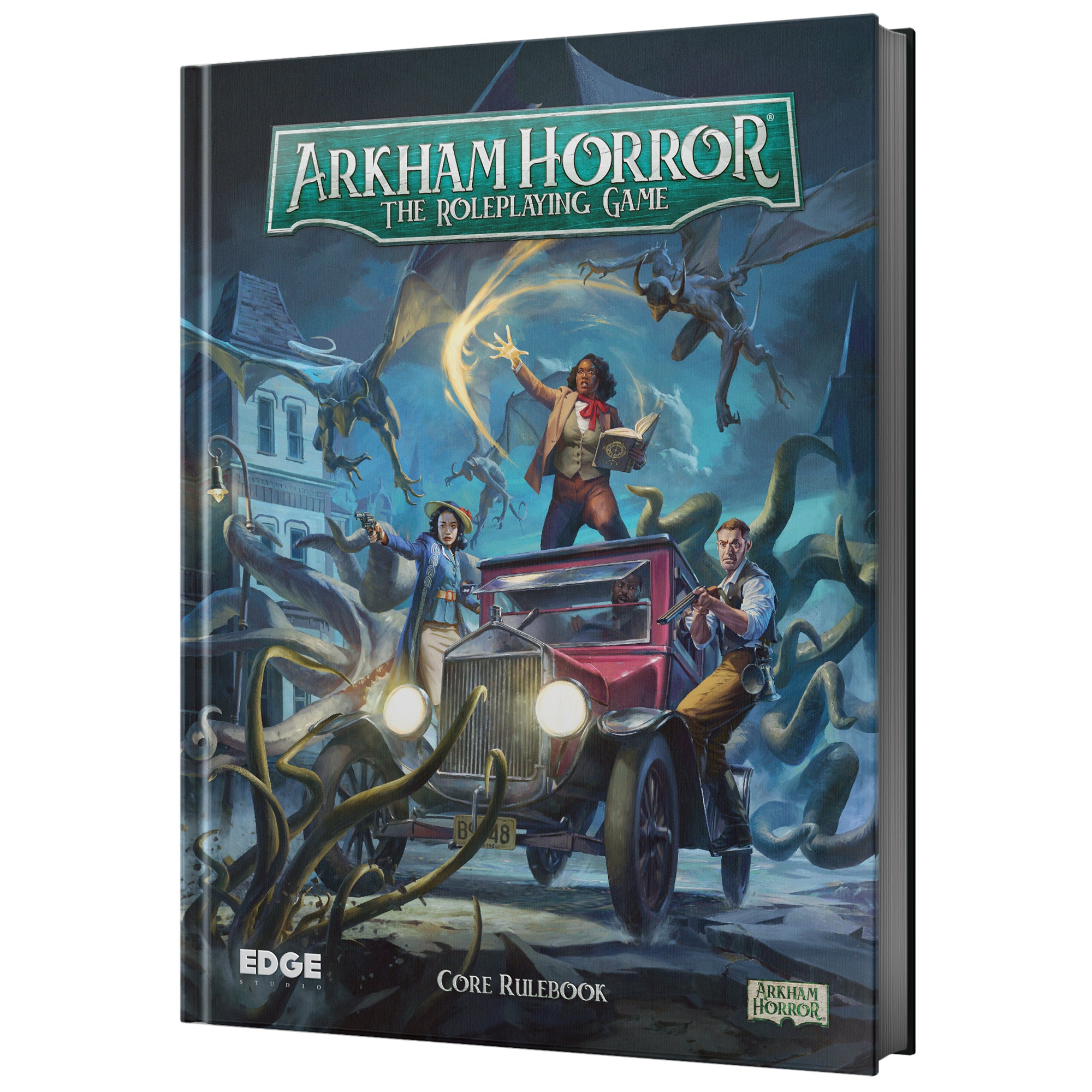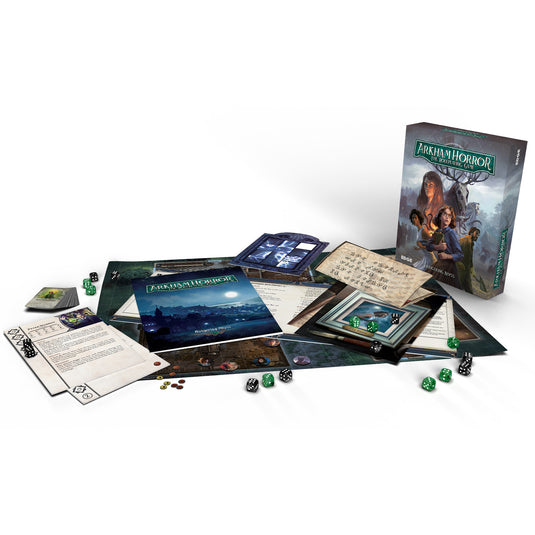Arkham Horror is a well-established name in the space of Lovecraftian horror, with a number of board games and other properties created by Edge Studios and distributed by the game publisher Asmodee. It’s a setting that visually captures the brilliance of the 1920s in Call of Cthulhu and offers a well-established board game for doing so.
What may surprise some is that they’ve recently created their own TTRPG with the same name. The Arkham Horror RPG starter kit was released over the summer, while the Core Rulebook was released this fall, offering players a taste of a new way to explore and fight Lovecraftian horror. But the game is yet another addition to a rather saturated market of TTRPGs, with games like Call of Cthulhu, Achtung Cthulhu and Trail of Cthulhu offering similar options for storytelling. So, how does Arkham Horror separate itself from competitors?
(Writer’s note: the writer received a free copy of the Arkham Horror Starter Kit and Core Rulebook courtesy of Asmodee for this article.)

What is Arkham Horror?
The Arkham Horror RPG is a Lovecraftian horror game in the vein of Call of Cthulhu. Players are investigators in a 1920s-era America who have either learned about or are learning about the supernatural entities that fill our world and must either investigate or act out to try and stop them. Perhaps a character is a socialite who’s had a run-in with the undead, or perhaps they’re a detective seeking a person who went missing. Either way, you’ve realized that we’re not alone in this world and you have to decide how to act on it. The game’s flavor is near-identical to that of CoC, although it brings some more modern concepts to the property (such as placing the story in a sort of ‘timeless’ area that avoids the historical realities of sexism and racism at the time.)
The Arkham Horror RPG relies on D6es for nearly every task or scene and brings a more tactical element to the game that CoC lacks in its combat; as well as a “board game-iness” to activities.
Players build investigators based on eight archetypes, whom they then customize with details about their demeanor, history and “knacks,” the feats and special abilities that each character possesses. The archetypes are more action-oriented than the occupations of CoC, featuring names like Guardian, Adventurer, and Believer.
Each character has a pool of dice available to them that also reflects their health pool. They have this as their primary resource during the game’s two main forms of content: “narrative scenes” and “combat scenes.” If they’re in a narrative scene, they can use this for various actions or checks as they feel is necessary. Combat scenes are more systematic, with players refilling their dice pool at the beginning of their turn.
If a player wants to complete a task, they take a certain number of D6 dice in their pool, from a single dice to all of them. They then roll the dice and attempt to get a result above the metric that they have listed on their sheet. So if they have a 5+, then that means that they have to roll a 5 or a 6 to succeed at the task. The number of successes reflects the level of success the character has! These include tasks in combat, and is designed to be used alongside tactical maps as you would in something like Pathfinder or Dungeons and Dragons.
These same dice reflect their health pool in two ways. Like most horror-focused games, Arkham Horror RPG has player characters track their physical and mental health. As players get hit more in combat, they lose dice in their dice pool. If they lose mental health, then they swap out regular dice with what’s called “Horror Dice.” These dice are of different colors and are supposed to be used first. The only mechanical difference is that if a player takes horror dice, then they’re forced to roll on a table to see if they take a trauma, or a mental injury.
If a character loses enough mental health or physical health, then they either go insane or lose their minds.
These abilities are all modified by one’s archetypes and knacks, but that’s the core gameplay mechanics.

How does Arkham Horror feel?
The one thing that AH presents is a significantly easier mechanic at first glance. While the percentile-based CoC system is a fairly reliable system on its face, it can seem overwhelming. AH, in contrast, draws on design aspects resembling those of its board game predecessors. The Starter Kit, for example, tried to capture this with a number of cardboard tokens and icons that the players could use to track sanity, health, dice pools and other things. It also had several cardboard puzzles included inside.
The dice are also easily visible and make it simpler for those with less TTRPG history to process things like health or abilities. The amount of dice it requires makes the game a bit of a struggle. If a storyteller wants to run a campaign for four players or so, they’ll need lots of D6es for the players and every NPC or monster they run themselves. The reliance on dice as a health mechanic is excellent because it keeps things like health above the board, but it may be a blunder for those who are not natural dice goblins. The Starter Kit only came with 24 dice in total, arguably only enough for the DM and two other players to use. (most TTRPG players probably have enough dice at home, but it’s best not to assume that players will have piles upon piles of dice.) There was also lots of card stacks and monster cards to help the storyteller and player throughout gameplay.
Character creation took little time, and explaining the rules took even less time. The Arkham Horror RPG Core Rulebook is also full of story hooks and details about Arkham, Massachusetts (the setting used for most content.) There is a prewritten adventure that’s fairly easy to run and offers a relatively standard investigative mystery involving monsters and cults. Sticking to the very economy-heavy approach to storytelling was a personal struggle (since things like checks and attempts were a limited currency per scene,) but I can see it becoming tenable over time.
The Arkham Horror RPG is best described as an attempt to “board gamify” Call of Cthulhu at a TTRPG setting. The game’s designed intentionally to be played at a table and relies on a lot of things like physical dice and cards in order to operate. This may be a fun way to approach a TTRPG for those who prefer their cardboard and dice over just theatre of the mind mechanics or who might want to approach the Lovecraft world with a bit more tactical mindset. For others who want a more flexible system less reliant on physical mechanics, this may be a struggle. It’s up to the storyteller and table’s preference to determine if this alternate Lovecraft horror setting is up their alley.
Images via Edge Studios
Have strong thoughts about this piece you need to share? Or maybe there’s something else on your mind you’re wanting to talk about with fellow Fandomentals? Head on over to our Community server to join in the conversation!


